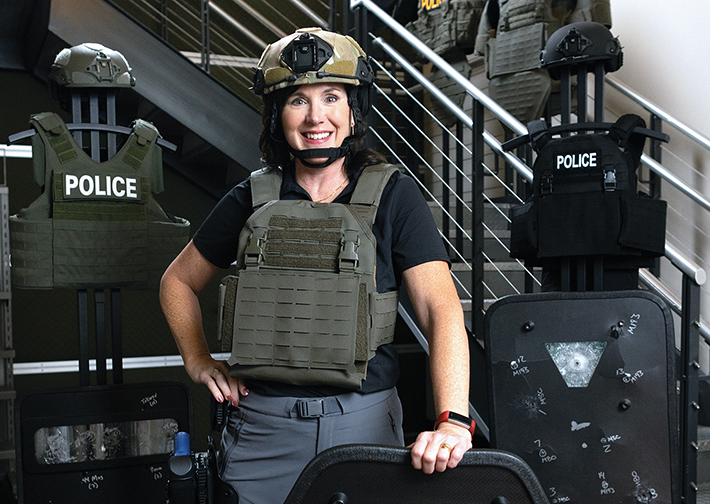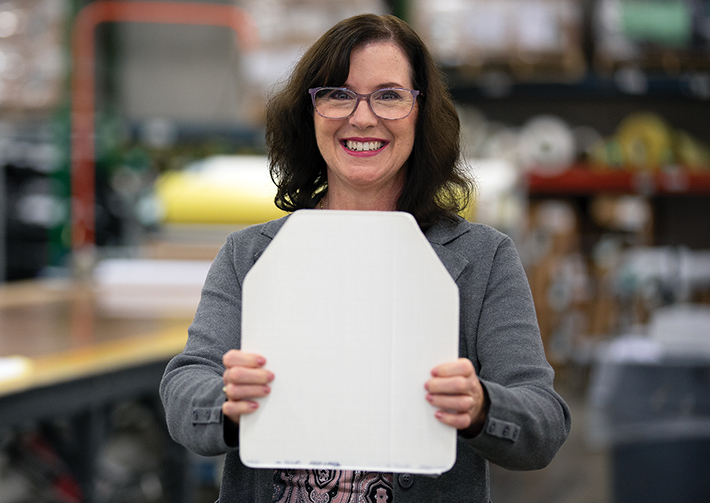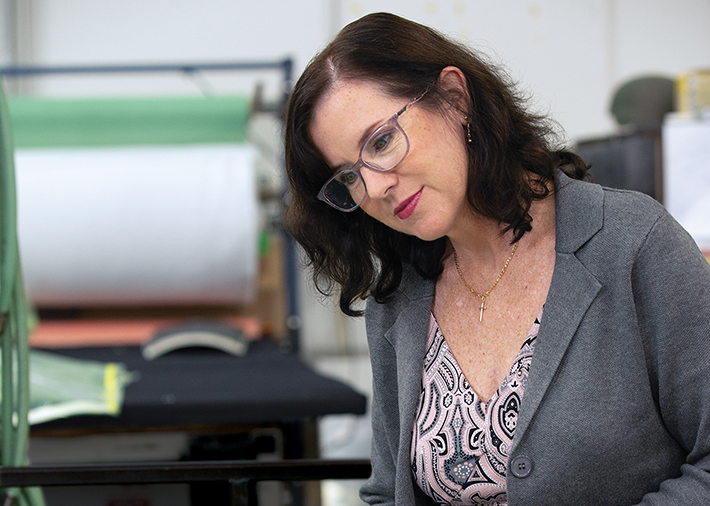
Bulletproof Commitment
Not many people can say their daily work helps save lives in a direct sense. 2025 ASTM Chair Cassy Robinson can. The graduate of Clemson University’s School of Engineering will tell you the importance of this work candidly, in a southern accent worthy of Dolly Parton herself. Her career in the field of personal protection and homeland security has helped keep first responders and members of law enforcement safer for 25 years now.
“Saving the life of a law-enforcement officer impacts not just that person, but also their families and their whole community,” says the engineer with the Department of Homeland Security’s (DHS) National Urban Security Technology Laboratory (NUSTL). “I’ve met many responders who were saved by their protective equipment, and standards are a vital part of ensuring their equipment performs as expected. This past summer, my colleague’s son, who is an officer with the New York City Police Department, was shot but saved by his body armor. That’s why I am committed to working with responders and developing standards for their equipment.”
FOR YOU: Standards for Safer Schools, Safer Children
When asked about her career journey and biographical details, Robinson tells us: “It’s a long story” and launches in, before pausing midway through to laugh: “I’m not done yet. I told you it’s a long story!”
Robinson joined ASTM International in 2006 and before joining NUSTL, worked for the U.S. Department of Energy Savannah River National Laboratory (SRNL); the National Institute of Justice (NIJ) as a detailee from SRNL; and the U.S. National Institute of Standards and Technology (NIST).
She is chair of the committee on homeland security applications (E54) and vice chair of three E54 subcommittees. She is also a member of the committee on personal protective clothing and equipment (F23). Her contributions to ASTM were recognized with an Award of Merit. In addition to the bachelor’s degree in electrical engineering from Clemson University, Robinson earned a master’s degree in industrial and systems engineering from the University of Alabama.
Standardization News caught up with Cassy at Safariland in Jacksonville, Florida, where the company manufactures ballistic-resistant body armor, helmets, and shields for law enforcement.
Q. Tell us a little about how you came to work in the field of standards in general and then specifically at the National Urban Security Technology Laboratory, also known as "NUSTL."
A. My first engagement with ASTM International and standards development happened about 20 years ago. But my journey actually started when I took a summer internship in what is now the SRNL, at the Savannah River Site, in their robotics group. It was such an amazing experience that I went back to work there after graduation. The site is a Department of Energy facility built during the 1950s to support the nation’s defense programs during the Cold War, and it produced materials that were used in making nuclear weapons. That production process meant there were many areas with hazards to people: high radiation levels, radioactive contamination, a lot of chemicals and other things. In areas where those hazards were present, people couldn’t safely do work, so our robotics group designed, built, and deployed application-specific remote systems and robots to do those jobs.
To be able to respond to any operation on-site that required robots or remote viewing, we had to keep a huge cache of equipment and components on hand. Because of our experience with quickly creating tools and our cache of equipment, we began working with the NIJ in the late 1990s to support local law enforcement in our area with things like covert surveillance and search tools.

Ballistic-resistant body armor helps save lives.
When the World Trade Center attacks happened in 2001, our team was sent to New York City with our cache of robots, video systems, and other tools to help urban search-and-rescue teams and the FDNY to look for human survivors or remains in the debris field of ground zero. Most of my time was spent putting up remotely operated pan-tilt-zoom camera systems in tall buildings surrounding ground zero. The firefighters could use a joystick to remotely adjust the camera’s view while looking at a large video monitor for things of interest in the debris field.
Before that, they had to use binoculars for a whole shift to watch what was going on and search the debris field, so it made their jobs much easier and more effective. The second thing we did was put together small camera-and-light assemblies on extendable poles that the teams could take into the debris field. They would insert the cameras through small openings into cavities where people may have been trapped. We also had robots with us, which we attempted to deploy, but the robots of that time period just could not navigate the terrain and didn’t work in that application. Following that, the DHS, in collaboration with the NIJ, sponsored a study of urban search-and-rescue technology needs and tasked my group to lead the effort. One of the highest priority needs was improved search robots, and DHS later funded NIST to lead the development of response robot standards through the committee on homeland security applications (E54). Joining that committee was my first touch point with ASTM standards.
These experiences led to an assignment with the NIJ in their standards and testing program. And that’s where I first became a “standards geek” working on standards for body armor, bomb suits, holsters, restraints, and several other things. During that time, I met my two mentors in standards from NIST and subsequently went to work there, continuing to work in standards and conformity assessment for law enforcement. In May 2023, I left NIST to move to the NUSTL, where our mission is supporting responders. Over the past 20 years, my work has steadily become more focused on responders and standards.
Q. What are some of the most important technologies being developed in the field of homeland security and public safety? Which do you think will be the most disruptive or impactful going forward?
A. I believe that it’s going to be a game changer as responder organizations begin using robots in their operations more and more, especially drones. They give the fire department, for instance, situational awareness. They’re the eye in the sky for an event like a high-rise building fire, giving firefighters a view they never had before to see what’s going on in that fire. Also, they are used for things like beach patrol and finding swimmers who are in distress in the ocean. Drones can be used to deliver medical supplies to accident victims that a responder cannot get to directly on foot or by vehicle and can provide two-way communications with a person who’s in distress to reassure them and let them know help is on the way. News footage from Hurricane Helene response showed drones being used in significant ways to locate people and deliver supplies to those who were isolated from help. Those are tremendous developments for public safety.
I believe another game changer in terms of technology development that is going to impact public safety and responders is the use of artificial intelligence (AI) in so many things, such as computer-aided dispatch. When a 911 call comes in, a human answers the phone and begins asking the caller a series of questions about their emergency. At the same time, AI can begin to analyze the information that’s being received and information from past calls to make suggestions about the most appropriate response in terms of who and what to send that will be most helpful.
You’re currently the chair of the homeland security committee. Tell us about some of the most important work being done in that committee.
I feel that the most impactful work being done in E54 is related to response robots, again the test methods that have been developed are so widely used, and they’re having a tremendous impact not only on the performance of robots but also in assessing the performance of the operators of those robots. They’re going a step beyond the robot itself, into whether the person operating it is qualified to do what they’re trying to do in a situation. Secondly, I feel that the work we’re doing in ballistic protection for law-enforcement officers is tremendous. For example, we have now developed standards for ballistic-resistant shields.

The process of manufacturing protective equipment is painstaking.
The standard that was previously used was developed 30 years ago by the NIJ, and it required minimal testing on an armor coupon representing a shield’s construction, not an actual shield. That standard required only five shots on the armor coupon, and the pass-fail requirement was no penetrations in those five shots. The problem with that approach is there’s much more to a shield than just the material of the shield body, including the viewport the person looks through; the interface between the shield body and that viewport; fasteners; weak points; and edges – the entire shield needed to be assessed and verified to perform. ASTM has developed two new standards for ballistic shields with significantly improved test methods and requirements. Actual shields, of the largest and smallest sizes sold, are required to be impacted with at least 50 shots following two different sequences of high and low conditioning with submersion, and there can be no complete penetrations for the shield to pass. I am excited about how these new standards will enhance responder safety and operations.
Q. How important has ASTM and its standards-development process been to the work you’re doing?
A. ASTM’s process allows stakeholders with different perspectives to collaborate on standards and harmonize standards across different organizations. As an example, about 10 years ago, an effort was begun to harmonize body armor test methods and procedures between the U.S. Army and the NIJ. These organizations have different end users who operate in different situations – soldiers on a battlefield versus law-enforcement officers in communities – but many of the procedures and test methods were similar, so we decided to harmonize standards, to the extent possible, through ASTM. This has resulted in a suite of test methods and procedures that are now referenced by the Army and NIJ. Doing this effort through ASTM’s consensus process allows any interested stakeholders to be involved and express their perspective and opinions, and share their knowledge and experience. At the end of the day, we have to work together to come to consensus, making tradeoffs between requirements and what’s actually possible with technology, so that everyone comes away knowing we created a quality standard that meets the need.
Q. Talk a little about the role an organization like the Safety Equipment Institute (SEI) plays in your field. How important is SEI to the world of standards and tell us about the role they play.
A. Developing a standard for a piece of equipment is a really important first step, but it’s not the only step. As a committee, we are always looking forward, asking how this standard is going to be used. That includes asking: Who is going to verify that the equipment actually meets the standard? SEI is one of the organizations that has filled that role for responder equipment for many years by certifying a range of products from firefighter respirators to bomb suits. Certification yields a very high level of confidence in a product’s performance because of the rigorous process, which typically involves four steps.
First, the product is tested to the standard pre-market, and once certified, the product goes to the market with authorization to put the certifier’s mark of conformity on the label. Then, surveillance testing is done on a periodic basis, many times annually. Two additional steps in the process include inspections of facilities where the products are manufactured and an audit of the manufacturer’s quality system. These steps together give a high level of confidence in a product’s pre-market performance and continued performance over time, and the process results in two helpful outcomes for responders: product labels that can be checked by end users and an online listing of certified products that can be checked by purchasers. However, certification is an expensive process, and sometimes, the market cannot bear that cost.
READ MORE: Safer Children's Costumes
In the past couple of years, SEI has offered another conformity-assessment option, called the “ASTM Verification Program,” which includes pre-market and surveillance testing to ASTM standards (excluding the other two steps of certification). Verification gives an acceptable level of confidence in a product’s performance at a reduced cost, making it more affordable for manufacturers to verify products. The verification process results in products being labeled as verified and an online listing of verified products.
Q. How important are events like ASTM’s Exo Games, which were hosted at headquarters for the first time in 2024, in getting students more involved with the organization?
A. I’m really excited about ASTM’s work with exoskeletons, especially the Exo Games for first responders. I had the opportunity to attend this year’s event in August, along with one of my colleagues from NUSTL. We saw the exoskeletons the student teams designed and built, learned about the capabilities, and watched as the teams put their exoskeletons through numerous responder scenarios, including those for a bomb technician, for a firefighter, and for search and rescue. The teams competed to see who did the best job with their exoskeleton. The best things about the event were the collaboration between the teams and the learning process that those students had gone through at their universities – learning about standards, learning about exoskeletons, and learning about the needs of first responders. This event brings together students, responders, and standards, and I’m really excited that my laboratory, NUSTL, is going to host the Exo Games in 2025.
Q. What would you say to an early career professional who is thinking about joining one of your committees – or ASTM in general?
A. Whenever I’m talking to a young person, whether they’re still in college or they’re a new professional just starting their career, I encourage them to look at the standards available in their field, to look at the standards developers that are out there, to consider how they can be involved, and then to get involved. I feel strongly about this because it’s been such a career-accelerator for me. It opens up a world you didn’t even know existed, a world of opportunities, a world of learning and good experiences. I loved going into my first committee meeting and seeing people in person who I knew were leaders in the field, world-renowned experts that I would never have gotten to meet, much less work with and collaborate with otherwise. There’s so much to learn and grow from in that process.●
David Walsh is ASTM's Content Director and the Editor in Chief of Standardization News.
 SN Home
SN Home Archive
Archive Advertisers
Advertisers Masthead
Masthead RateCard
RateCard Subscribe
Subscribe Email Editor
Email Editor